How To Do Redbud Tree Care?
Plant redbud tree in a location where there is partial sun and ample space to flourish. These trees enjoy well-drained and watered alkaline soil.
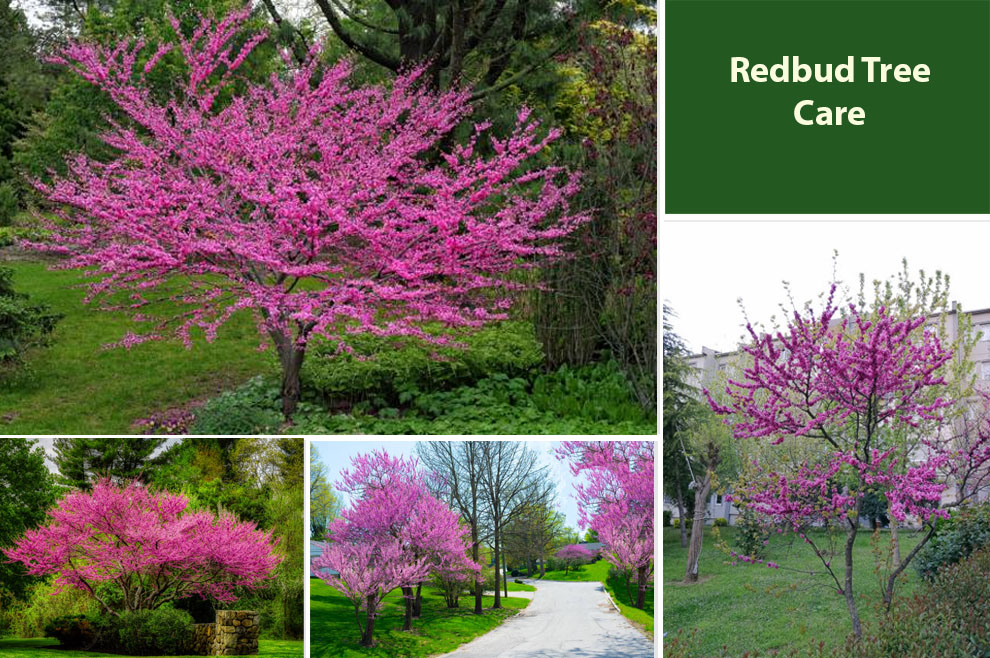
Redbud trees are typically the first to show in spring. Once they bloom, they beautifully put on a show that is a sight to behold. It may not be very well known, but it is well recognized. So, if you wish to add delightful color to your landscape, Redbud is an excellent addition.
The tree blooms in late winter through early spring to display attractive pink to reddish-purple flowers and attracts beneficial birds with its brown to purple beanlike pods and insects with its flowers. It grows best in USDA hardiness zones six through nine.
They are small plants and grow up to twenty-five feet with an equal spread. The tree grows only two to three feet per year, and has a long lifespan of 150 years, provided it is exposed to the right conditions.
Fortunately, the Redbud tree care is pretty straightforward. They grow in well-draining soil and partial sun. They enjoy heavy infrequent watering. Once the tree establishes, you do not have to put in any effort toward its survival.
But the question is, what must you do for its upkeep and maintenance in the long run? Read below as we unfold everything you must know about the care guidelines for a Redbud tree.
How To Care For A Redbud Tree?
Caring for a redbud variety is pretty straightforward. So, if you seek a low-maintenance plant for your garden, this can be a good pick. Water is the plant’s most crucial requirement. So, while it is new, water it deeply in the initial few years, especially during droughts.
A new Redbud needs approximately fifteen gallons of water per week. Proficient gardeners suggest it is best to water deeply but infrequently than a daily skirt because it helps the roots stay close to the surface.
After a year or two from planting, the roots will spread and get stronger to meet the plant’s water requirements. So now the Redbud tree care demands lowering the watering frequency.
So, it is safe to irrigate the plant solely during the dry periods. After the plant establishes, it becomes more drought-tolerant than most smaller trees and shrubs. However, take active measures to keep it guarded against pests and diseases.
Pruning is not a must for the Redbuds. They have a beautiful shape naturally. But, if you spot any dead, crossing, or broken branches, you can trim them. Overall taking care of Redbud is straightforward and can be performed by beginners too.
Below we will detail the care instructions for every crucial aspect.
A. Where, when, and how to plant the Redbud?
1. Where?
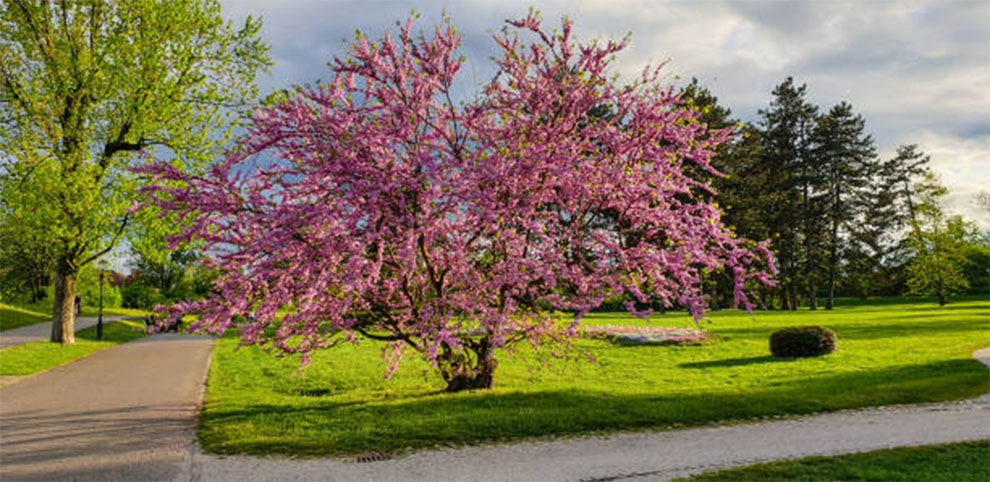
First things first, when planting the Redbud, it is essential to be cautious when selecting the location as Redbud is one plant that almost hates transplantation. Moreover, once it establishes, it grows approximately two feet per year. Thus, ensure that the chosen site has ample space to accommodate the Redbud.
In addition, the site must be at least eight away from any existing structure, like a septic tank or garage. It helps avoid any costly damage from root disturbance. Even though you must keep the plant away from taller structures, you may plant it close to the fences as they do not have a deep foundation.
But ensure that there is at least three feet gap between the Redbud and the fences. If you plant more than one Redbuds, leave at least twelve feet gap between them.
The plant thrives in partial shade. But it can also tolerate fun sun or lighter sun positions, but there must be shade from the intense heat of the midday sun.
2. When?
Planting at the right time is vital for Redbud tree care. Fortunately, you can grow Redbuds during most parts of the year. But never plant them during the hard freezes and the warm summer months.
3. How?
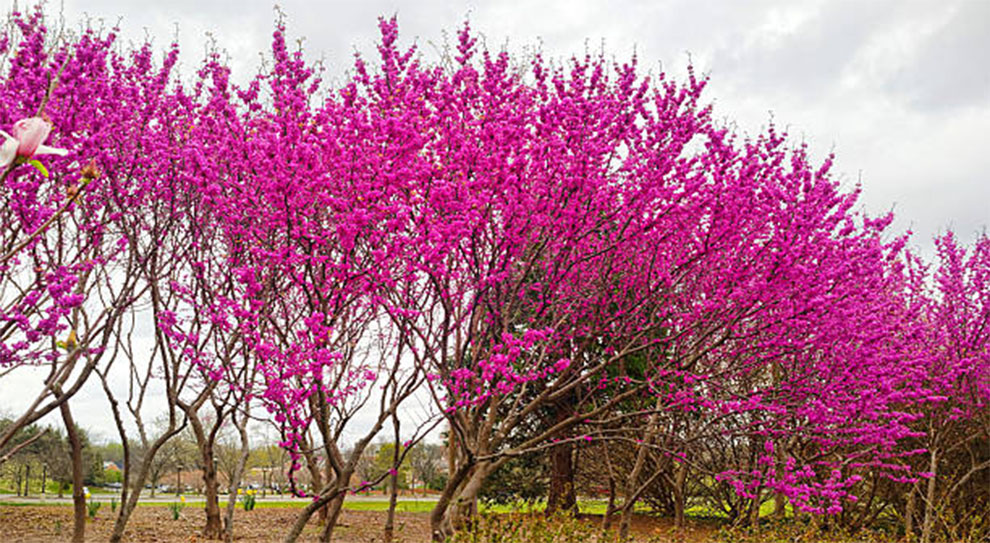
Next, if you do not grow the Redbuds right, any care exerted towards it will not prove fruitful. So, how you plant your Redbuds is also crucial. Here are the steps to follow:
- Take a shovel and dig a giant hole into the ground, ensuring it is about three times as wide as the plant’s root ball. While the ball is inserted into the hole, it should sit at level with or somewhat above ground level.
- If you are ok with the hole’s size, remove the tree from its container or burlap wrap. If it is compacted, rub the roots to uncurl and loosen the outer roots.
- Insert the plant into the hole such that it stands as straight as possible, and the root system’s top end must be at level with or even a little above the ground level.
- Once positioned as required, you can backfill the hole. You can have someone hold the plant as you add the soil into the hole.
- Once the hole is fifty percent full, you can water it well. Let the water drain before filling the hole.
- Press the soil together gently, and water again.
- Add a three-inch thick mulch layer around the tree, ensuring it does not touch the bark. Mulching can help retain moisture and keep the root system cool.
Related: Growing redbud tree from seeds
B. Climate
Native to the eastern regions of North America, Redbuds will thrive in USDA hardiness zones four through nine. So, before planting, you must also examine whether the plant is suited for your location. If not, you may have to take extra measures for your redbud tree to thrive.
C. Water

If planted in the spring, Redbud trees require occasional watering during the first year, especially during the dry spells. Redbud plants are shallow-rooted. Hence, roots take a while to spread out and establish.
On the contrary, the Redbud care will be different if you plant the tree in winter or fall. In this period, the plant will not require any supplemental water. Another advantage of fall planting is that it gives the plant ample time for its roots to grow.
Moreover, since the soil will be colder and damp, the plant will have sufficient water for the entire duration.
D. Soil
At all times, the plant needs well-draining soil to grow. If the growing soil has poor drainage, you can add some organic matter like compost to better the drainage. Further, before you plant your tree, weed around the site, clearing about three feet of soil from your chosen location.
The plant thrives best in acidic to slightly alkaline soil, So if you are unsure about its profile, consider getting a soil examination done. This test can help you understand the soil’s precise makeup. Even though the plant can grow in various conditions, it does best in alkaline soil ranging from 6.5 to 8 on the pH scale.
How to take care of Redbud tree if its pH is not alkaline? Typically, the garden soil ranges between 6.0 to 7.0. To increase the soil’s pH, you can add pelletized limestone. But, if you wish to lower the soil pH and make it more acidic, consider adding chelated iron, aluminum sulfate, or soil sulfur.
Adding organic compost into the soil or using mulch can also help elevate the acidity and achieve ideal growing conditions.
E. Is mulching needed or not?
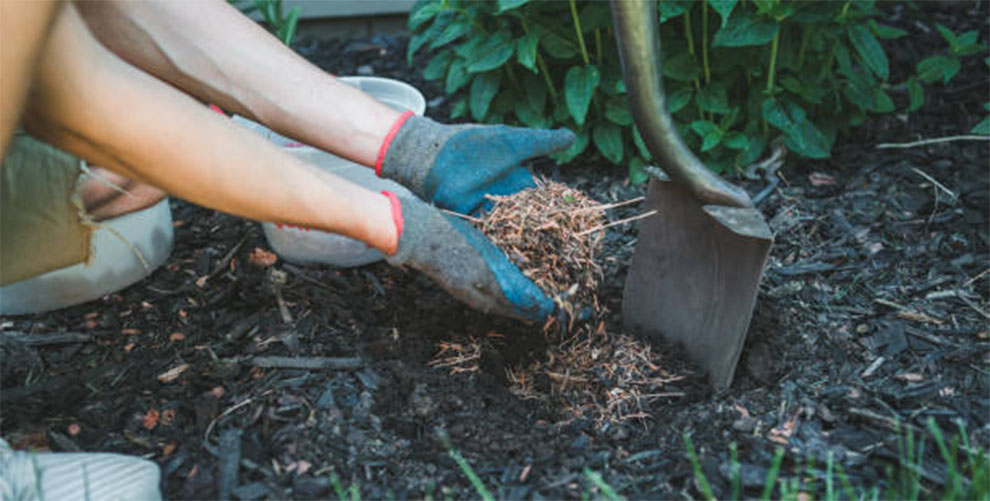
It helps to add a two to three-inch thick mulch layer around the base as it can help lower the weeds and retain moisture levels. But pull the mulch away from the tree and spread it evenly to keep pests and diseases at bay.
F. What is the best fertilizer for Redbud trees?
Redbuds prefer organic soil. So, consider using organic fertilizers like compost or manure to achieve success with your plant. Work them into the soil at the rate of one bushel for every one-inch trunk caliper. Over time, the tree grows, and its root system extends beyond the bed. It is when you can consider using other redbud fertilizers too.
All kinds of liquid, granular, or stake-type fertilizers work well. However, we recommend fertilizing only once a year, particularly in the late fall after the leaf drop. Some even consider feeding in the early spring when the buds open. 10-10-10 multi-purpose fertilizer works best for the plant.
In the younger years, the plant prefers a nitrogen-rich fertilizer or one with a 20-20-20 mix or the alike. But, after it matures, you can lower the fertilizing frequency or opt for low-nitrogen feeds.
G. How do you prune and shape a Redbud tree?
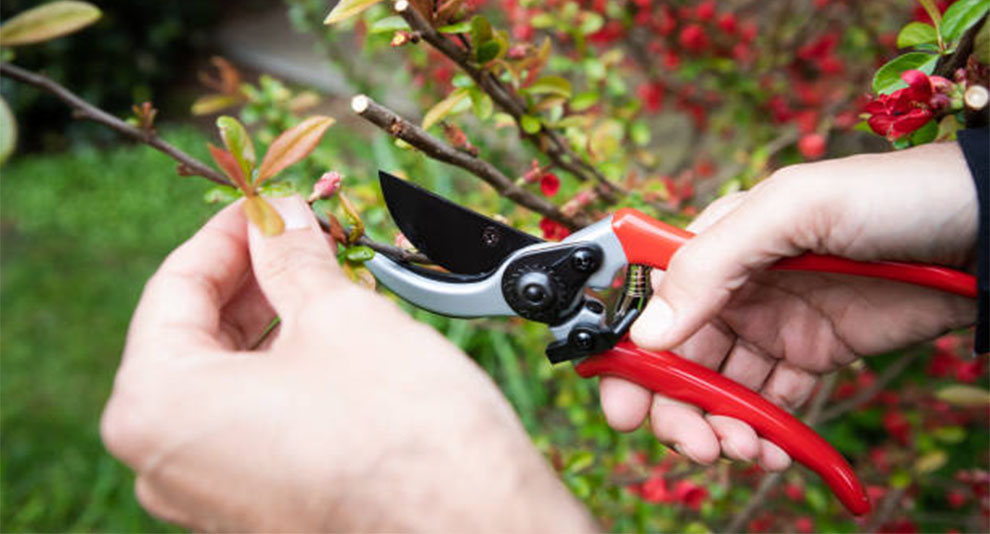
Though Redbud does not need heavy pruning, we recommend chopping any diseased, dead, crossing, or damaged branches. It helps keep the plant strong. While trimming, ensure that you do not leave a stub as they look bad and even delay the plant’s ability to heal from pruning. Thus, we recommend following the limb to the next offshoot and cutting just a little above the next branch.
On the larger branches, you can see a raised collar noticeable on the bark. Chop the branch just beyond the collar so that the collar stays on the tree. If you do not know where the collar is, we recommend leaving a small stub for good Redbud care instead of cutting it into the collar.
Using hand pruners, you can prune smaller branches about one-half inch or smaller in diameter. If the shoots are over three inches in diameter, you must remove them with loopers. If there are any larger branches, use a hand saw. When using the hand saw, start with the undercut to avoid the weight of the removed limp from peeling the bark and damaging the tree.
Redbud Tree Problems and Solutions
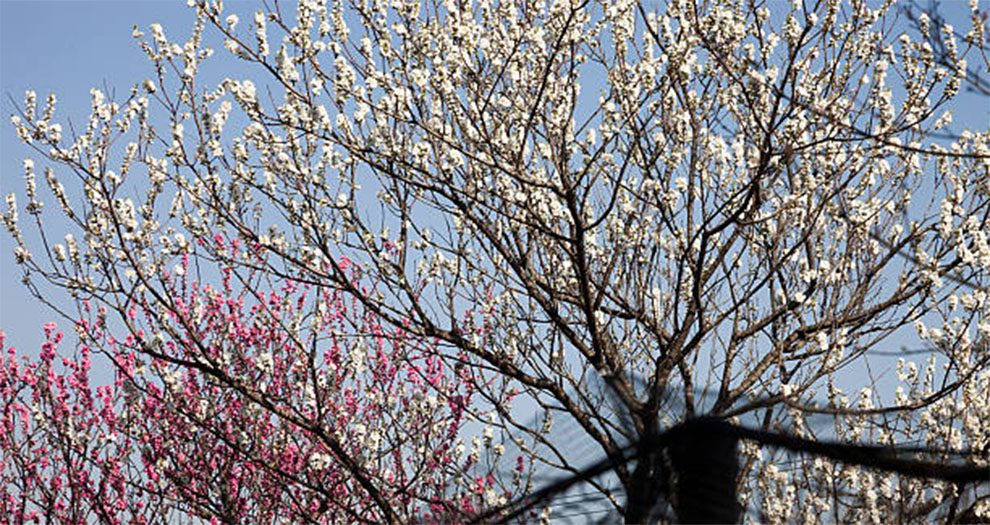
Even though Redbuds demand little care, there are some problems that you need to watch out for. A few of them are:
A. Botryosphaeria canker
Prolonged stress and drought can result in cankers. It is a sign of pathogenic fungi. To prevent it, you must apply a thick mulch layer in the summer. It helps preserve moisture. However, if the cankers appear, you can prune the infected branches approximately six inches below the visible cankers.
B. Verticillium wilt
If the Redbud trees turn yellow, it is a sign of verticillium wilt, which typically attacks the plant via its root system. To avoid this disease, you must ensure that the soil is moist. However, you must never overwater the plant.
But, if your plant shows wilt signs, you must instantly prune the infected branches. Sadly, if most of the tree is wilt-infected, it might not survive.
C. Leaf-eating insects
Weevils, caterpillars, and leafhoppers might infest the Redbud trees. Hence, if they damage the leaves, you must immediately trim the infected leaves and follow them up with a suitable insecticide.
D. Scale
Scales can be another problematic pest infecting the Redbud trees. They tend to suck the fluid from the foliage, resulting in yellowing, wilting, or dropping leaves. You can overcome this infestation with horticultural oil or insecticidal soap. Alternatively, releasing natural predators onto the plant may also help. Parasitic wasps and predatory lacewings target the scale bugs.
E. Mouse and rabbit attack
Redbuds often suffer a mouse or a rabbit attack. To prevent this, you should conceal the trunk’s lower part from the ground to approximately 2.5 feet upwards with a mesh or cloth. It helps guard the tree against most pests.
Redbud Tree Variety Specific Care
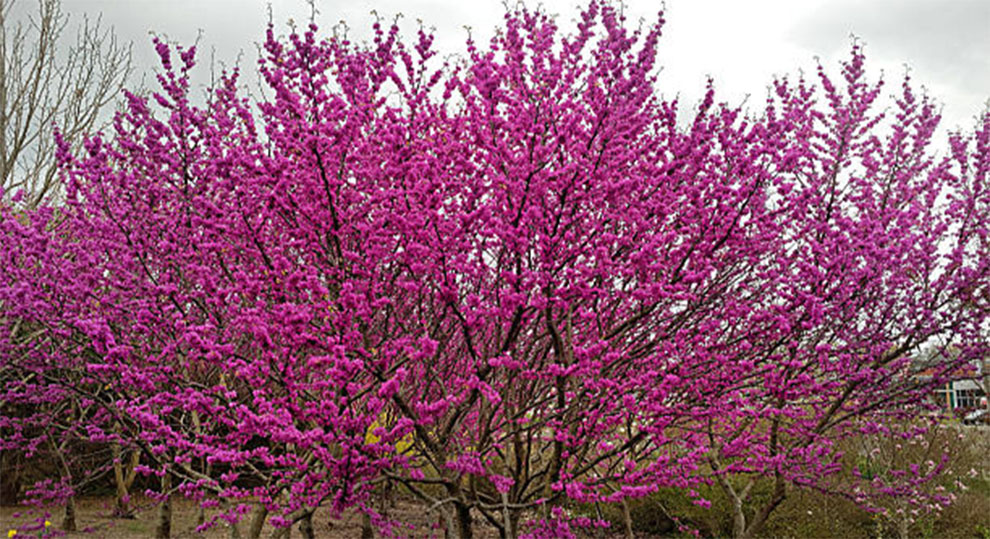
A. Eastern Redbud Care
Eastern Redbud thrives in USDA hardiness zones four through eight. Native to eastern and midwestern America, they are drought-tolerant after a year or two from planting. It does not like transplanting. So, be careful while choosing the location.
Protect its branches from strong winds as they are vulnerable to breakage. Prune in winter before the blooming period commences. You can start pruning while the plant is young to form a strong structure and control multiple trunks from growing.
B. Western Redbud
Western Redbud can adapt to temperature fluctuations ranging from -18 degrees in the winter to 32 degrees Celsius in the summer. To flower, the plant needs a temperature lower than -2 degrees. Studies suggest that the plant is hardy to 40 degrees and thrives in areas with rainfall between 51 and 127 cm.
It is drought-resistant but desires ample water to grow. They thrive in full sun and different soils provided they are moist and well-draining with a pH between 6.6 and 7.8.
C. American Redbud Tree Care
These trees grow best in USDA zones four through nine. They prefer full sun to partial shade conditions and enjoy direct, unfiltered sun for at least four hours daily. Such trees can grow in loamy, alkaline, acidic, well-drained, sandy, rich, and clay soils.
D. Weeping Redbud
They are hardy in USDA hardiness zones five through nine and grow best in well-draining, moist soil, where it receives full sun to part shade. You must feed them with a general-purpose fertilizer during spring before the flowers show. They are black walnut-tolerant and deer-resistant. You can prune them while dormant. Once established, they do not transplant well. So, pick the planting site after research.
Frequently Asked Questions
Ques 1. Can you overwater a Redbud tree?
Ans. Redbuds do not like sitting in waterlogged soil. So, never overwater them. It increases the susceptibility to fungal diseases and might even kill the plant.
Ques 2. How many years does it take for a Redbud tree to bloom?
Ans. Redbud trees may start blooming as early as four years from the plantation.
Ques 3. What is the life expectancy of a Redbud tree?
Ans. Most Redbuds live between 50 to 75 years.
